Background Intro
Similar to the time you invest in your skin care routine, we believe your hair deserves the same attention. We often see flawless hair on social media (like Pinterest) and wish we could have it too.
Hair care is a very important routine that involves proper grooming and using the right hair care products. We're here to help you achieve your hair goals and create a perfect hair care routine that works for your hair type.

What are the major hair types?
Your hair type depends on genetics. In other words, the curl pattern of your hair is closely related to the shape of your hair follicles. When your hair follicles are round or irregularly shaped, your hair tends to be more curly. Hairstylist Andre Walker pioneered the hair classification system, which divides all hair types into four categories:
Type 1 - Straight
Straight hair is most common; it looks smooth and silky, and is flat from the crown to the ends of the hair. It is not easily curled or knotted and is soft to the touch. Asian women usually have this hair type.Their hair can look greasy if they don't shampoo frequently. Straight hair is the easiest to care for, but the hardest to style.
Type 2 - Wavy
Naturally wavy hair has more curl than straight hair and less than curly hair types. It takes on the shape of a wave as it rises, like the letter "s". This natural hair - type looks loose and gives a sense of languor. It has a coarse texture, which makes it easy to style. Whether you want to curl or straighten, this natural hair type can be achieved immediately and will keep the style longer.
Type 3 - Curly
Curly hair has a spiral shape, usually described by the letter "z". This hair type looks full of volume, vibrant and has a fixed, natural structure. It has irregular hair follicles and the hair is more prone to frizz, breakage, tangles or dryness. Therefore, it requires proper maintenance to avoid hair damage.
Type 4 - Kinky
This hair type has the highest degree of curl and is shaped like tight ringlets. The hair is kinky and has hair texture. Most African Americans have this coily hair. The dense curl causes the oil produced by the scalp to not reach the hair shaft, so the texture of kinky hair is also rough and it is more fragile. Heat styling tools and chemical dyes can do great harm to kinky hair. People with this hair type have an itchy or dry scalp from time to time and we recommend adding an extra serious hair care routine to alleviate this symptom to get healthy hair.
The above is the most basic classification. In fact, each category can also be subdivided into more specific types based on criteria such as texture, thickness, density, and curl level. From A to C, indicating from straight to curly, from fine to coarse, from smooth to coarse, etc. You can get details from the following picture.
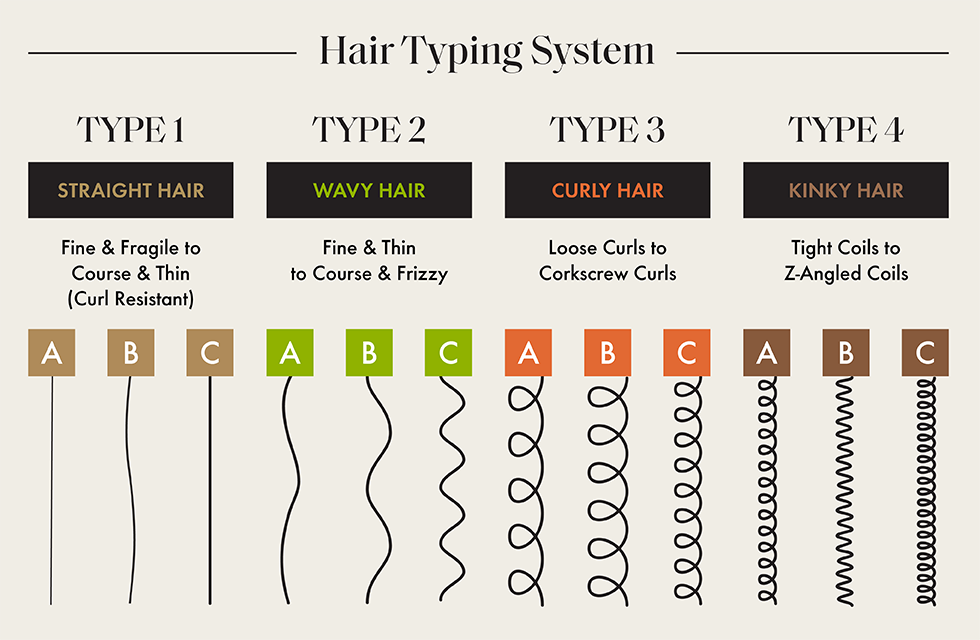
How to identify your hair type?
Now, you have learned about the four hair types. You may still be confused and not know how to identify your hair type. We have listed five aspects. You can consider them all together to determine your hair type.
Related: How To Get The Perfect Hairstyle According To Your Face Shape?
#1 Appearance
The appearance of your hair is the easiest to determine.
- To Make Sure You Can Make An Accurate Judgment, Wash Your Hair First. During This Time, Do Not Add Any Hair Care Products.
- Remember To Let Your Hair Air Dry. When It Is Completely Dry, Observe Whether It Is Straight, Wavy Curly Or Kinky.
Based on the specific descriptions of the previous four hair types and the graphical presentation, you can quickly figure out which category your hair appearance falls into. According to expert research, hair can exhibit a variety of characteristics. If you notice that some of your hair is curly and some is wavy, you may have difficulty recognizing your curl pattern. You may also find that the thickness of your hair is inconsistent. These are all very common conditions. You just need to choose the one that will accentuate the overall look.
#2 Diameter
The width of a hair strand is the diameter of the hair. It gives an accurate representation of your hair type. You can do a hair strand test. Usually we use the touch method to complete the test. Hold some of the hair strands between your index finger and thumb and feel the hair. Gently rub your finger back and forth.
- If You Have Difficulty Feeling The Presence Of The Hair, You Have Very Fine Hair.
- If You Can Feel The Hair Slightly, It Is Medium Hair.
- If You Feel A Strong Presence Of Hair, It Is Thick Hair.

The sewing thread is about the same thickness as a hair. You can put hair strands and threads together for comparison. If it is about the same width as the thread, your hair is medium; if it is thinner than the thread, your hair is sparse; if it is thicker than the thread, your hair is thick.
#3 Density
Hair density refers to how many hair strands you have on your scalp. This is not the same as the diameter of the hair mentioned above. Your hair may be thick, but less dense, and the reverse is also true. Comb the side part of your hair to the other side and look at your scalp in the mirror at.
- The Degree Of Exposure Of Your Scalp Is Obvious, Indicating Very Little Density.
- You Can See Part Of Your Scalp Through Your Hair, Indicating Medium Density.
- You Can Barely See The Scalp, Indicating A High Density.
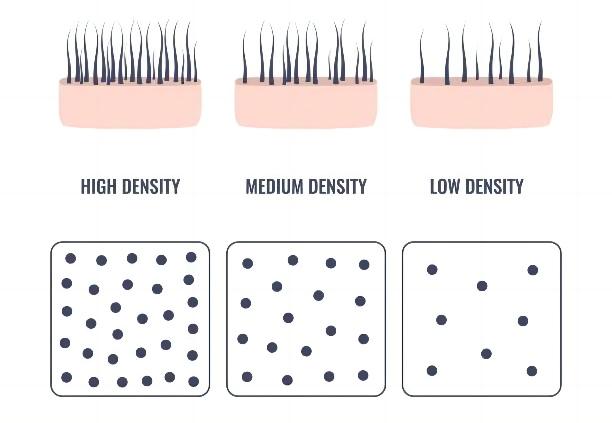
#4 Porosity
Porosity reflects the hair's ability to absorb moisture and lock it in place. Higher porosity will allow your hair to absorb more moisture and products. To figure out the porosity of your hair, you need to prepare a glass of water and a strand of your dry hair. Soak the dry hair strand in the water and observe its position in the water.
- If You Notice That The Hair Strand Is Floating On The Surface Of The Water, This Indicates That The Hair Has Low Porosity.
- If You Find That Your Hair Lies Between The Horizontal Surface And The Bottom Of The Cup And Can Be Balanced, It Proves That The Porosity Of Your Hair Is Medium (Normal). No Extra Care Is Needed For This Hair Type To Stay Healthy.
- If The Hair Sinks To The Bottom Of The Cup, It Means You Have A High Porosity Hair.It Can Absorb A Lot Of Moisture And Hair Products, But It Is Also Easy To Be Damaged. Chemicals Can Easily Invade The Cuticle And Cause Frizzy Hair. This Hair Type Can Dry Out Quickly After Cleansing.
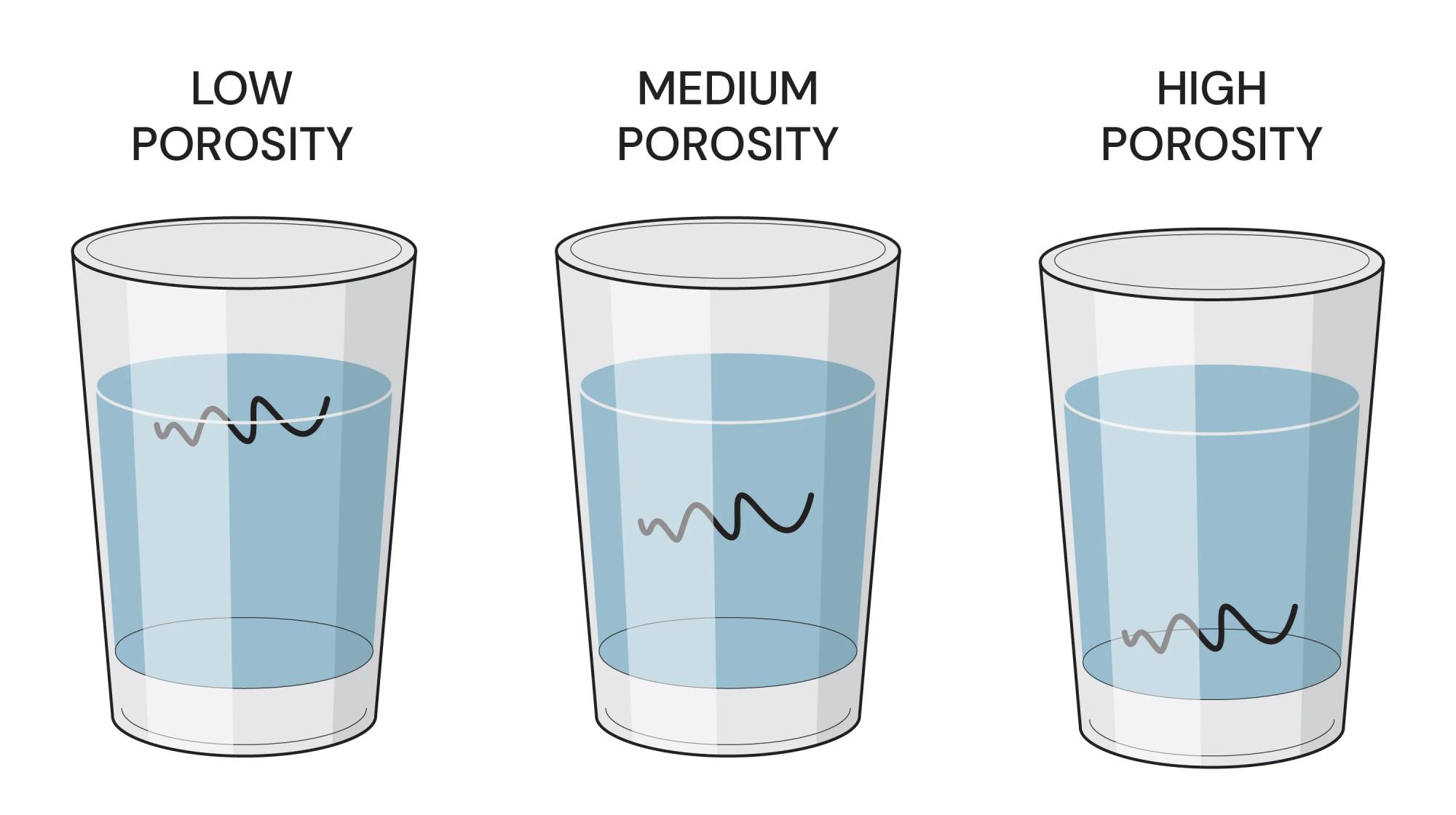
#5 Scalp oiliness
Scalp oiliness is also an important aspect in determining hair quality. We need to do a scalp test to confirm the greasiness. Wash and dry your hair naturally at night before going to bed. The next morning, press the scalp with a tissue, especially on the top of the head and behind the ears. The amount of oil that attaches to the tissue will indicate the greasiness of your hair.
- If There Is Almost No Oil On The Tissue, It Means You Have A Dry Scalp And Are More Dehydrated.
- If The Oil Stains Are Light, It Means Your Scalp Is Normal. It Is Able To Achieve A Water-Oil Balance.
- If The Oil Spot Deposited On The Tissue Is Heavy, Your Have Oily Hair.
- If Only Specific Areas Leave Oil Stains On The Tissue, It Proves That Your Scalp Is Mixed. Typically, The Area Above The Temples And Behind The Ears Will Show A Lot Of Oil.

How to maintain hair based on your hair type?
Each hair type can be improved and become perfect with a few tips and the proper products for you. Don't silky strands of hair look satisfying? They are glowing, smooth and leave you trying to reach out them. That's why here are some secret hair care tips for you to get those silky locks.
Related: How To Attach And Maintain Hair Toppers For Beginners?`
How To Style Your Wig Like A Pro: Step-By-Step Tutorials
#1 Hair care routine for straight hair
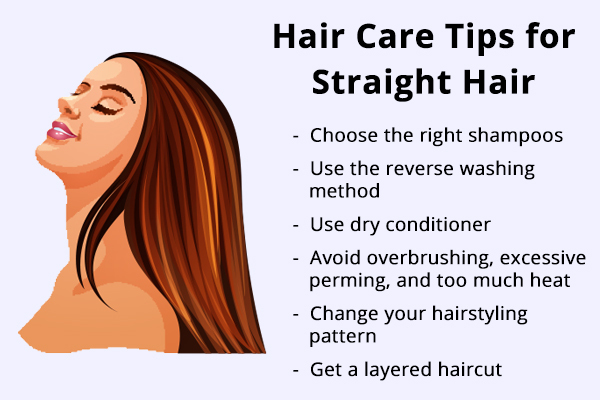
"How to wash?"
• Avoid choosing shampoos that contain sulfates. Sulfate-free shampoos can remove excess oil and clean up dirt. You can also use hair products that help retain some of the oil to ensure that your hair is not dry.
• If you have a dry scalp, keep the frequency of washing your hair to once every 2-3 days to allow room for the production of oils. If you have oily hair, you can wash your hair every other day.
"How to condition?"
• Choose a conditioner with simple ingredients rather than a leave-in conditioner. This will prevent your hair from being oily and make your hair feel lighter.
• Conditioners that contain jojoba oil or coconut oil are good choices. They will help your dry hair lock in moisture and make the strands soft and smooth without adding weight.
• Remember to only put conditioner to your hair shaft and not apply conditioner to the roots to avoid your hair becoming greasy and sticking to your scalp.
• Volumizing mousse will make the roots of your hair voluminous. Apply on wet hair and let it air dry.
"How to style?"
• If you wish to see more volume, flip your hair over and blow dry in layers, combing through with a round brush as you go.
• Learn about dry shampoo. Straight hair tends to get oily quickly, and you can prevent this in advance by spraying some dry shampoo into the roots. It absorbs the oil and reduces the number of times you have to wash your hair.
• If you have thin hair, we recommend applying some texturizer, which helps to add volume and texture to your hair and make it look more vibrant.
"How to trim?"
• If you have less width in your hair, you can try blunt hair. It is ideal for people with fine hair because it creates extra volume and makes the hair look thicker. If you have larger hair width, you can try layering the look to get more movement in your hair.
#2 Hair care routine for wavy hair
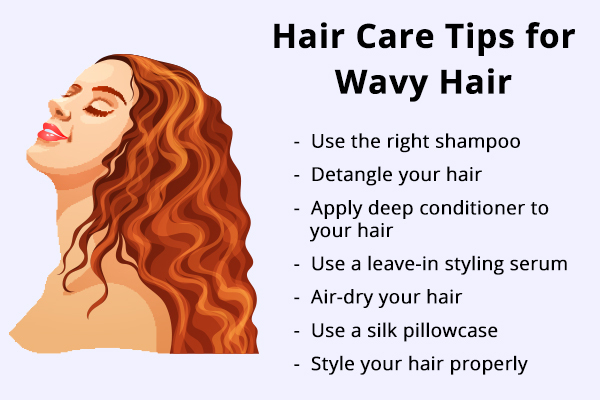
"How to wash?"
• Compared to straight hair, wavy hair is not as greasy. Therefore, you don't need to wash it as often. Washing every 3-4 days is best.
• You should use a shampoo specifically designed for wavy hair. It will not damage the original shape of the hair. Be careful to choose one that is sulfate-free.
"How to condition?"
• Before washing your hair, you can use apply a wash of essential oil on your hair. Gently massage your hair and scalp with your fingers to help keep your hair moist and healthy. The massage should not be too long or too short, it is best to maintain it for about 1 hour.
• If you have enough free time, taking good care of your hair before each wash can be a good way to protect it. Before going to bed, put on a cozy silk sleep cap to keep your look and lock in moisture.
Related: Why You Should Wear A Sleep Cap And How To Pick The Right One?
• Generally speaking, for wavy hair types that is drier than straight hair, you need to use jojoba oil or vitamin e to keep the hair shaft and ends hydrated to avoid frizzy hair.
• Use a leave-in conditioner to keep your locks hydrated throughout the day. Apply it to wet hair after a shower and curl your hair in the direction of the bend to make the waves stand out more. Put all your hair in your hands and hold it tightly and then release it intermittently to give it more bounce. Finally, dry your hair.
"How to style?"
To make your waves more pronounced, refer to this method.
• Apply styling mousse to the roots and ends (while hair is wet).
• To reduce frizz and keep your hair hydrated, you will need to apply a hair oil. Start from the mid-shaft and work your way to the ends of your hair. Do not apply to the roots, this will cause the hair to look greasy.
• Attach a diffuser to your hair dryer and leave the ends of your hair that need to be dried on the diffuser for a while. Doing so will distribute the airflow evenly and ensure the integrity of the natural wave.
• When your hair is almost dry (90% is the dry hair now), turn the hair dryer off. Afterwards, if your hair feels a little dry, add some hair oil or finishing cream to the ends to prevent frizz and achieve the look of natural waves.
• If you want to get a sexy look, you might as well spray some texturizer at the roots.
"How to trim?"
• For people with thinning hair, adding overall layers is most important. It can provide you with more volume. For people with thick hair, you need to add looseness to your hair to give it a more vibrant look. The shorter your hair is, the more bend it will have. We recommend that you keep your hair long to reduce the amount of curl in your short hair too.
Related: What Makes Hair Toppers The Wonderful Choice For Thinning Hair?
What Is The Best Wig For Baldness & Thinning Hair?
#3 Hair care routine for curly hair
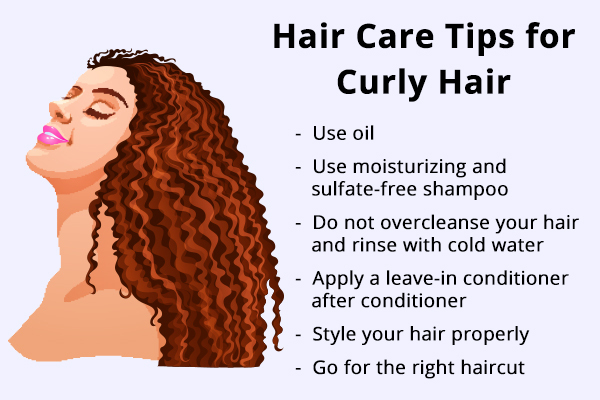
"How to wash?"
• A sulfate-free shampoo is always the best choice. Curly hair is more prone to dryness than both wavy and straight hair, so you should provide it with adequate hydration. You only need to use shampoo on the scalp, which is where dirt is most likely to accumulate.
• While shampoo cleanses, it also takes away essential nutrients and oils. To avoid making your hair frizzy or overly dehydrated, you should not apply shampoo to the skin around the hair shaft.
• For curly hair, washing your hair once a week is enough. This will help to relieve dry hair.
"How to condition?"
• Moisture is your best friend for curly hair. You can put conditioner on your hair every 3-4 days to moisturize your hair and keep it soft. You can also increase the frequency of conditioning depending on your hair care routine, products and personal situation.
• Adding a few drops of essential oil to the conditioner will protect the hair cuticle, contribute to retaining scalp oils and help lock in moisture. You can also use a hair mask to make your curls frizz free.
• When using deep condition, you should keep your head down and let your hair hang down, slowly smoothing it from the mid-shaft to the ends. This will prevent it from breaking. You can't brush out curly or coily hair to detangle it. Doing so can result in frizzy hair or damaged hair.
• Don't neglect deep conditioning, which is an important part of your healthy hair care routine . You can follow up your conditioner with a hair mask after rinsing it out. Let the hair mask stay on your hair for 10-15 minutes. Using a hair mask once every two weeks is appropriate. It can also promote hair growth.
• If you want your hair to have more pronounced ringlets, consider a curl defining cream. Remember to wear a silk sleep cap before going to bed.
• Too much heat can dry out your locks, leaving them vulnerable and susceptible to breakage. Purchase a diffuser. It will dry your hair in a fixed pattern without causing it to become dehydrated.
"How to Style?"
• The appeal of curly hair is the gorgeous look and rich volume. To enhance the curl, try a curling gel, which will set your curly hair style for longer. You can even apply curling gel to all your hair. However, if you want a lighter look, you will need to reduce the amount of hairspray.
• Curly hair is more likely to become dull in comparison to straight and wavy hair types. Therefore, hair oil is necessary. It calms down the cuticle and enhance shine.
• After showering, you should brush your hair while it is wet to avoid tangles. Be sure to use a wet hair brush, which has softer, finer fibers that won't cause much friction or tug on your hair.
• It is a good idea to let your hair air dry. The lowest temperature blow drying is also possible. A diffuser works well for curly hair, it maintains the style and gives your hair volume and fullness.
"How to trim?"
• The length of your natural curls, is determined by your personal style and preference. As with naturally wavy hair, the shorter the hair, the easier it is to curl. If you tend to lean towards a lively and enthusiastic look, you can cut your hair down to your collarbone; if you prefer a more elegant and demure style, it is fine to leave it down to your waist.
#4 Hair care routine for kinky hair
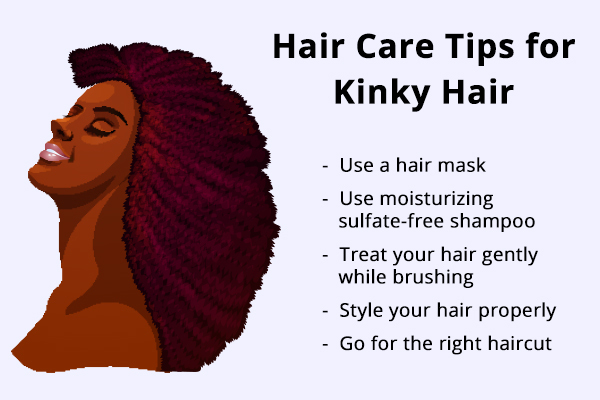
"How to wash?"
• You can never go wrong with a mild, moisturizing shampoo that is sulfate-free. It won't irritate your skin or hair, and it won't take away much of the natural oils and moisture from shiny hair.
• You should focus on washing the roots of your coily hair, but be careful to avoid the hairline properly. The lint at the hairline is much finer and more fragile, so too much friction can cause it to fall out. Also, it is not necessary to use a lot of hair products and you should not massage it for too long. This can cause moisture loss from kinky hair.
"How to condition?"
• It is appropriate to use conditioner 2-3 times a week. Apply conditioner to protect your damaged hair after each wash.
• Add deep conditioning to your daily hair care routine. You can use hair masks. It can also remove split ends and deeply hydrate your hair. Kinky hair is the most fragile and breakage prone hair type, so you should take care of it.
• Kinky hair is the most fragile and breakage prone hair, so you should perform a deep treatment at least once a week. This weekly hair care routine is essential if you have damaged or chemically treated hair.
Related: Hair Damage: What Causes It And How To Deal With It
• To provide your damaged hair with plenty of moisture and leave it soft to the touch, you can guiltily spray a moisturizing spray on your hair every day at intervals.
• An hour before you wash your hair, put some coconut oil into your dry hair.
• When using conditioner, use your fingers to gently separate the hair strands to prevent tangles and hair breakage.
"How to Style?"
• After washing your hair, you can pat your hair dry with a microfiber towel. This hair type can dry quickly, so it is good for air drying. Shield your strands from heat, UV rays, and toxins. Blow drying can make your hair dull.
• To minimize damage from heat styling, you can use a heat protectant.
• After your hair is completely dry, add a heavy oil or or leave-in conditioner with a curl defining agent to replenish the needed nutrients.
• Avoid tight ponytails or other hair styles that pull hair.
"How to trim?"
• Regular trimming is a great way to keep this hair type healthy. It helps remove split ends. However, you should avoid frequent trimming or cutting your hair too short.
Final Thoughts
Your hair deserves more care. Keep in mind that the ideal hair care routine is entirely up to you - your hair type, your hair goals, and how much time you have. Polish your hair care routine right now and enjoy healthy hair for months to come!
Contact us for any questions about your hair. We provide you with the most comprehensive hair care tips, styling tutorials and trend recommendations. In addition, we offer the best human hair wigs (including wigs for chemo and alopecia) and hair toppers. Click here to learn more.
Images credit: Google, Pinterest, Youtube.
